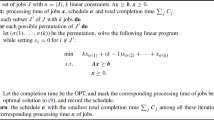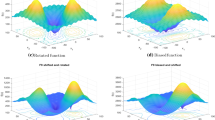Abstract
MAX-2-SAT is one of the representative combinatorial problems and is known to be NP-hard. Given a set of m clauses on n propositional variables, where each clause contains at most two literals and is weighted by a positive real, MAX-2-SAT asks to find a truth assignment that maximizes the total weight of satisfied clauses. In this paper, we propose branch-and-bound exact algorithms for MAX-2-SAT utilizing three kinds of lower bounds. All lower bounds are based on a directed graph that represents conflicts among clauses, and two of them use a set covering representation of MAX-2-SAT. Computational comparisons on benchmark instances disclose that these algorithms are highly effective in reducing the number of search tree nodes as well as the computation time.
Similar content being viewed by others
References
Alsinet, T., Manya, F., Planes, J.: Improved branch and bound algorithms for Max-SAT. In: Sixth International Conference on Theory and Applications of Satisfiability Testing, pp. 408–415 (2003)
Alsinet T., Manyà F., Planes J.: A Max-SAT solver with lazy data structures. In: Lemaître, C., Reyes, C.A., Gonzalez, J.A. (eds) Advances in Artificial Intelligence—IBERAMIA 2004. Lecture Notes in Artificial Intelligence, vol. 3315, pp. 334–342. Springer, Heidelberg (2004)
Amini M.M., Alidaee B., Kochenberger G.A.: A scatter search approach to unconstrained quadratic binary programs. In: Corne, D., Dorigo, M., Glover, F. (eds) New Ideas in Optimization, pp. 317–329. McGraw-Hill, London (1999)
Aspvall B., Plass M.R., Tarjan R.E.: A linear-time algorithm for testing the truth of certain quantified Boolean formulas. Inf. Process. Lett. 8, 121–123 (1979)
Bansal, N., Raman, V.: Upper bounds for MaxSat: Further improved. In: ISAAC ’99: Proceedings of the 10th International Symposium on Algorithms and Computation, pp. 247–258. Springer-Verlag, London (1999)
Bonami P., Minoux M.: Exact MAX-2SAT solution via lift-and-project closure. Oper. Res. Lett. 34, 387–393 (2006)
Borchers B., Furman J.: A two-phase exact algorithm for MAX-SAT and weighted MAX-SAT problems. J. Combin. Optim. 2, 299–306 (1999)
Boros, E.: Private communication via e-mail exchange (2007)
Boros, E., Hammer, P.L.: A max-flow approach to improved roof-duality in quadratic 0–1 minimization. RUTCOR Research Report RRR 15-1989, RUTCOR (1989)
Boros E., Hammer P.L.: Pseudo-Boolean optimization. Discrete Appl. Math. 123, 155–225 (2002)
Boros E., Crama Y., Hammer P.L.: Upper-bounds for quadratic 0–1 maximization. Oper. Res. Lett. 9, 73–79 (1990)
Boros E., Crama Y., Hammer P.L.: Chvátal cuts and odd cycle inequalities in quadratic 0–1 optimization. SIAM J. Discrete Math. 5, 163–177 (1992)
Boros, E., Hammer, P.L., Tavares, G.: Preprocessing of unconstrained quadratic binary optimization. RUTCOR Research Report RRR 10-2006, RUTCOR (2006)
Boros E., Hammer P.L., Sun R., Tavares G.: A max-flow approach to improved lower bounds for quadratic unconstrained binary optimization (QUBO). Discrete Optim. 5, 501–529 (2008)
Bourjolly, J.-M., Hammer, P.L., Pulleyblank, W.R., Simeone, B.: Combinatorial methods for bounding quadratic pseudo-Boolean functions. RUTCOR Research Report RRR 27-1989, RUTCOR (1989)
Bourjolly J.-M., Hammer P.L., Pulleyblank W.R., Simeone B.: Boolean-combinatorial bounding of maximum 2-satisfiability. In: Balci, O., Sharda, R., Zenios, S.A. (eds) Computer Science and Operations Research: New Developments in their Interfaces, pp. 23–42. Pergamon Press, Oxford (1992)
Cherkassky B.V., Goldberg A.V.: On implementing the push-relabel method for the maximum flow problem. Algorithmica 19, 390–410 (1997)
Cormen T.H., Leiserson C.E., Rivest R.L., Stein C.: Introduction to Algorithms. MIT Press, Cambridge (2001)
Davis M., Putnam H.: A computing procedure for quantification theory. J. ACM 7, 201–215 (1960)
de Givry S., Larrosa J., Meseguer P., Schiex T.: Solving Max-SAT as weighted CSP. In: Rossi, F. (eds) Principles and Practice of Constraint Programming (CP 2003). Lecture Notes in Computer Science, vol. 2833, pp. 363–376. Springer, Heidelberg (2003)
de Klerk E., Warners J.P.: Semidefinite programming approaches for MAX-2-SAT and MAX-3-SAT: Computational perspectives. In: Pardalos, P.M., Migdalas, A., Burkard, R.E. (eds) Combinatorial and Global Optimization. Series on Applied Optimization, vol. 14, pp. 161–176. World Scientific Publishers, Singapore (2002)
Eén N., Sörensson N.: An extensible SAT-solver. In: Giunchiglia, E., Tacchella, A. (eds) Theory and Applications of Satisfiability Testing—SAT 2003. Lecture Notes in Computer Science, vol. 2919, pp. 502–518. Springer, Heidelberg (2004)
Eén N., Sörensson N.: Translating pseudo-Boolean constraints into SAT. J. Satisfiability Boolean Model. Comput. 2, 1–25 (2006)
Even S., Itai A., Shamir A.: On the complexity of timetable and multicommodity flow problems. SIAM J. Comput. 5, 691–703 (1976)
Garey M.R., Johnson D.S., Stockmeyer L.: Some simplified NP-complete graph problems. Theor. Comput. Sci. 1, 237–267 (1976)
Gilmore P.C., Gomory R.E.: A linear programming approach to the cutting stock problem. Oper. Res. 9, 849–859 (1961)
Glover F., Kochenberger G., Alidaee B.: Adaptive memory tabu search for binary quadratic programs. Manage. Sci. 44, 336–345 (1998)
Glover F., Kochenberger G., Alidaee B., Amini M.: Tabu search with critical event memory: An enhanced application for binary quadratic programs. In: Voss, S., Martello, S., Osman, I.H., Roucairol, C. (eds) Meta-Heuristics: Advances and Trends in Local Search Paradigms for Optimization, pp. 93–109. Kluwer Academic Publishers, Boston (1999)
Glover F., Alidaee B., Rego C., Kochenberger G.: One-pass heuristics for large-scale unconstrained binary quadratic problems. Eur. J. Oper. Res. 137, 272–287 (2002)
Goldberg A.V., Tarjan R.E.: A new approach to the maximum-flow problem. J. ACM 35, 921–940 (1988)
Goldberg, E., Novikov, Y.: BerkMin: A fast and robust SAT solver. In: Design Automation and Test in Europe (DATE 2002), pp. 142–149 (2002)
Gramm, J., Niedermeier, R.: Faster exact solutions for MAX2SAT. In: Conference on Algorithms and Complexity, pp. 174–186 (2000)
Hammer P.L., Hansen P., Simeone B.: Roof duality, complementation and persistency in quadratic 0–1 optimization. Math. Program. 28, 121–155 (1984)
Hansen P., Jaumard B.: Algorithms for the maximum satisfiability problem. Computing 44, 279–303 (1990)
Heras F., Larrosa J., Oliveras A.: MiniMaxSAT: a new weighted Max-SAT solver. In: Marques-Silva, J., Sakallah, K.A. (eds) Theory and Applications of Satisfiability Testing—SAT 2007. Lecture Notes in Computer Science, vol. 4501, pp. 41–55. Springer, Heidelberg (2007)
Hirsch, E.A.: A new algorithm for MAX-2-SAT. In: STACS 2000: 17th Annual Symposium on Theoretical Aspects of Computer Science, pp. 65–73 (2000)
Johnson D.S.: Local optimization and the traveling salesman problem. In: Paterson, M.S. (eds) Automata, Languages and Programming. Lecture Notes in Computer Science, vol. 443, pp. 446–461. Springer, Heidelberg (1990)
Joy, S., Mitchell, J.E., Borchers, B.: Solving MAX-SAT and weighted MAX-SAT problems using branch-and-cut. Technical report, Mathematical Sciences, Rensselaer Polytechnic Institute, Troy, NY 12180 (1998)
Kirkpatrick S., Selman B.: Critical behavior in the satisfiability of random Boolean expressions. Science 264, 1297–1301 (1994)
Kochenberger G., Glover F., Alidaee B., Lewis K.: Using the unconstrained quadratic program to model and solve Max 2-SAT problems. Int. J. Oper. Res. 1, 89–100 (2005)
Koga, Y.: Efficient branch-and-bound algorithms for weighted MAX-2-SAT. Master’s thesis, Department of Applied Mathematics and Physics, Graduate School of Informatics, Kyoto University (2006)
Li C.-M., Manya F., Planes J.: New inference rules for Max-SAT. J. Artif. Intell. Res. 30, 321–359 (2007)
Lourenço H.R., Martin O.C., Stützle T.: Iterated local search. In: Glover, F., Kochenberger, G.A. (eds) Handbook of Metaheuristics, pp. 321–353. Kluwer Academic Publishers, Boston (2003)
Luby M., Ragde P.: A bidirectional shortest-path algorithm with good average-case behavior. Algorithmica 4, 551–567 (1989)
Mahajan Y.S., Fu Z., Malik S.: Zchaff2004: An efficient SAT solver. In: Hoos, H.H., Mitchell, D.G. (eds) Theory and Applications of Satisfiability Testing—SAT 2004. Lecture Notes in Computer Science, vol. 3542, pp. 360–375. Springer, Heidelberg (2005)
Martin O., Otto S.W., Felten E.W.: Large-step Markov chains for the traveling salesman problem. Complex Syst. 5, 299–326 (1991)
Merz P., Freisleben B.: Greedy and local search heuristics for unconstrained binary quadratic programming. J. Heuristics 8, 197–213 (2002)
Miyashiro R., Matsui T.: A polynomial-time algorithm to find an equitable home-away assignment. Oper. Res. Lett. 33, 235–241 (2005)
Miyashiro R., Matsui T.: Semidefinite programming based approaches to the break minimization problem. Comput. Oper. Res. 33, 1975–1982 (2006)
Moskewicz, M.W., Madigan, C.F., Zhao, Y., Zhang, L., Malik, S.: Chaff: Engineering an efficient SAT solver. In: Proceedings of the 39th Design Automation Conference (DAC 2001), pp. 530–535 (2001)
Niedermeier R., Rossmanith P.: New upper bounds for maximum satisfiability. J. Algorithms 36, 63–88 (2000)
Resende M.G.C., Pitsoulis L.S., Pardalos P.M.: Approximate solution of weighted MAX-SAT problems using GRASP. DIMACS Ser. Discrete Math. Theor. Comput. Sci. 35, 393–405 (1997)
Selman, B., Levesque, H.J., Mitchell, D.: A new method for solving hard satisfiability problems. In: Rosenbloom, P., Szolovits, P. (eds.) Proceedings of the Tenth National Conference on Artificial Intelligence, pp. 440–446. AAAI Press, Menlo Park (1992)
Selman, B., Kautz, H.A., Cohen, B.: Noise strategies for improving local search. In: Proceedings of the Twelfth National Conference on Artificial Intelligence (AAAI’94), pp. 337–343. Seattle (1994)
Shen, H., Zhang, H.: An empirical study of MAX-2-SAT phase transitions. In: LICS’03 Workshop on Typical Case Complexity and Phase Transitions, June (2003)
Shen, H., Zhang, H.: Improving exact algorithms for MAX-2-SAT. In: Eighth International Symposium on Artificial Intelligence and Mathematics, January (2004)
Shen, H., Zhang, H.: Study of lower bound functions for MAX-2-SAT. In: 19th National Conference on Artificial Intelligence (AAAI), pp. 185–190 (2004)
Simeone, B.: A generalized consensus approach to nonlinear 0–1 minimization. Technical Report CORR 38/79, Department of Combinatorics and Optimization, University of Waterloo (1979)
Simeone, B.: Quadratic 0–1 Programming, Boolean Functions, and Graphs. Ph.D. dissertation, Department of Combinatorics and Optimization, University of Waterloo (1979)
Smyth K., Hoos H.H., Stützle T.: Iterated robust tabu search for MAX-SAT. In: Xiang, Y., Brahim, C.-D. Advances in Artificial Intelligence: 16th Conference of the Canadian Society for Computational Studies of Intelligence (AI 2003). Lecture Notes in Artificial Intelligence, vol. 2671, pp. 129–144. Springer, Heidelberg (2003)
Tavares, G.: Max2SatGen: A generator of weighted MAX-2-SAT formulas. RUTCOR, Rutgers University (2005)
Tompkins D.A.D., Hoos H.H.: UBCSAT: An implementation and experimentation environment for SLS algorithms for SAT and MAX-SAT. In: Hoos, H.H., Mitchell, D.G. (eds) Theory and Applications of Satisfiability Testing—SAT 2004. Lecture Notes in Computer Science, vol. 3542, pp. 306–320. Springer, Heidelberg (2005)
Trick, M.A.: A schedule-then-break approach to sports timetabling. In: PATAT ’00: Selected papers from the Third International Conference on Practice and Theory of Automated Timetabling III, pp. 242–253. Springer, Heidelberg (2001)
Wallace, R.J.: Enhancing maximum satisfiability algorithms with pure literal strategies. In: McCalla, G. (ed.) Advances in Artificial Intelligence: 11th Biennial Conference of the Canadian Society for Computational Studies of Intelligence (AI96). Lecture Notes in Computer Science, vol. 1081 (1996)
Wallace, R.J., Freuder, E.C.: Comparative studies of constraint satisfaction and Davis-Putnam algorithms for maximum satisfiability problems. In: Johnson, D.S., Trick, M.A. (eds.) Cliques, Coloring, and Satisfiability. DIMACS Series in Discrete Mathematics and Theoretical Computer Science, vol. 26, pp. 587–615 (1996)
Xing Z., Zhang W.: MaxSolver: An efficient exact algorithm for (weighted) maximum satisfiability. Artif. Intell. 164, 47–80 (2005)
Yagiura M., Ibaraki T.: Analyses on the 2 and 3-flip neighborhoods for the MAX SAT. J. Combin. Optim. 3, 95–114 (1999)
Yagiura M., Ibaraki T.: Efficient 2 and 3-flip neighborhood search algorithms for the MAX SAT: Experimental evaluation. J. Heuristics 7, 423–442 (2001)
Yannakakis M.: On the approximation of maximum satisfiability. J. Algorithms 17, 475–502 (1994)
Zhang, H.: SATO: An efficient propositional prover. In: Proceedings of the International Conference on Automated Deduction (CADE’97), pp. 272–275 (1997)
Zhang H., Shen H., Manyà F.: Exact algorithms for MAX-SAT. Electronic Notes in Theoretical Computer Science 86(1), 190–203 (2003)
Author information
Authors and Affiliations
Corresponding author
Rights and permissions
About this article
Cite this article
Ibaraki, T., Imamichi, T., Koga, Y. et al. Efficient branch-and-bound algorithms for weighted MAX-2-SAT. Math. Program. 127, 297–343 (2011). https://doi.org/10.1007/s10107-009-0285-6
Received:
Accepted:
Published:
Issue Date:
DOI: https://doi.org/10.1007/s10107-009-0285-6




